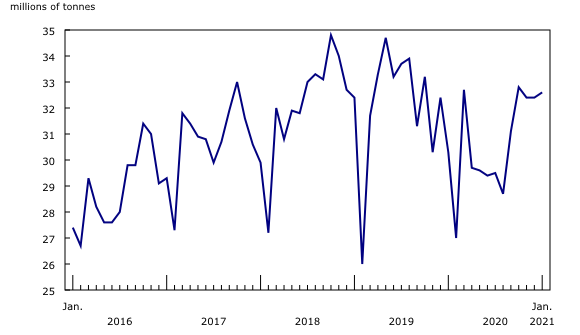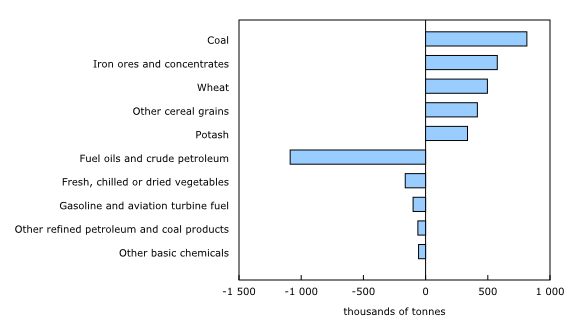Railway carloadings, January 2021
Archived Content
Information identified as archived is provided for reference, research or recordkeeping purposes. It is not subject to the Government of Canada Web Standards and has not been altered or updated since it was archived. Please "contact us" to request a format other than those available.
Released: 2021-03-22
32.6 million metric tonnes
January 2021
7.7% 
(12-month change)
Highlights
In January, the volume of cargo carried by Canadian railways reached 32.6 million tonnes, up 7.7% from January 2020. This marked the third straight month of year-over-year growth.
The overall tonnage was higher than normal for this time of year, well above the five-year average for the month of January and surpassing the prior record of 32.4 million tonnes set in January 2019.
Coal and iron ores pick up
The rail traffic growth in January reflected a higher volume of both domestic non-intermodal and intermodal loadings.
Domestic non-intermodal freight traffic grew 8.6% year over year to 26.2 million tonnes in January, mainly as a result of a sharp increase in loadings of two key inputs required for steelmaking—coal and iron ores. Together, these two commodities accounted for over two-thirds (67.2%) of the total increase in non-intermodal loadings.
Loadings of coal, which have been on a downward trend since April 2020, surged by 35.5% (+814 000 tonnes) in January from the same month in 2020, more than offsetting the year-over-year decline of 11.5% (or -372 000 tonnes) in December 2020. Similarly, loadings of iron ores and concentrates were 13.0% higher (+576 000 tonnes) in January compared with the same month in 2020.
Increased loadings of these two commodities coincided with a rebound in global steel production. According to the World Steel Association, member countries reported a 4.8% year-over-year increase in crude steel production in January. Exports of iron ore and concentrates posted a healthy increase in January, according to data on Canadian international merchandise trade.
Loadings of many agricultural and food products continued to exhibit growth, with demand for grains and oilseeds remaining strong. Wheat loadings, on an upward trend since May 2020, rose 28.6% (+497 000 tonnes) year over year in January, following similar increases in November (+24.0%) and December 2020 (+21.4%). Likewise, loadings of other cereals increased by 416 000 tonnes—almost four times the volume in January 2020—, marking the tenth consecutive month of year-over-year increases.
Finally, loadings of potash rose year over year for the eighth straight month, up 22.5% (+337 000 tonnes) from January 2020, reflecting continued strong global demand for fertilizers.
Energy products continue to slide
Growth in non-intermodal freight traffic was moderated by the continued decline in loadings of some hydrocarbon-based commodities. In particular, loadings of fuel oils and crude petroleum declined year over year for the tenth consecutive month, down 45.1% (-1 089 000 tonnes) in January, following similar year-over-year declines in November (-35.2%) and December 2020 (-40.5%).
Travel restrictions and limited air travel continued to temper demand for energy products. For example, gasoline and aviation turbine fuel loadings, which have fallen year over year each month since April 2020, dropped another 40.2% (-101 000 tonnes) in January, while other refined petroleum and coal products were down 14.6% (-62 000 tonnes).
In addition, other declines were reported in fresh, chilled or dried vegetables, with loadings falling 33.8% (-164 000 tonnes) below January 2020 levels—the third consecutive month of decrease. Loadings of other basic chemicals (-9.0% or -57 000 tonnes) also fell year over year, their second monthly decline in a row.
Finally, in January, domestic intermodal loadings—mainly containers—remained well above the volume posted the same month a year earlier for the fifth consecutive month, rising 20.0% from January 2020 to 3.1 million tonnes—the highest monthly volume for a month of January on record.
American freight continues to trend down
Traffic received from the United States saw a year-over-year decline for the tenth straight month, dipping 7.3% to 3.3 million tonnes in January, after a 10.4% year-over-year decline the previous month.
Note to readers
Data are subject to revisions. The Monthly Railway Carloadings data are revised, on a monthly basis, for the month immediately prior to the current reference month being published to reflect new information provided by respondents. The data in this release are not seasonally adjusted.
The Monthly Railway Carloadings Survey collects data on the number of rail cars, tonnage, units and 20-feet equivalent units from railway transporters operating in Canada that provide for-hire freight services.
The Transportation Data and Information Hub, a web portal developed jointly by Statistics Canada and Transport Canada, provides Canadians with online access to comprehensive statistics and measures on the country's transportation sector.
Contact information
For more information, or to enquire about the concepts, methods or data quality of this release, contact us (toll-free 1-800-263-1136; 514-283-8300; STATCAN.infostats-infostats.STATCAN@canada.ca) or Media Relations (613-951-4636; STATCAN.mediahotline-ligneinfomedias.STATCAN@canada.ca).
- Date modified:



